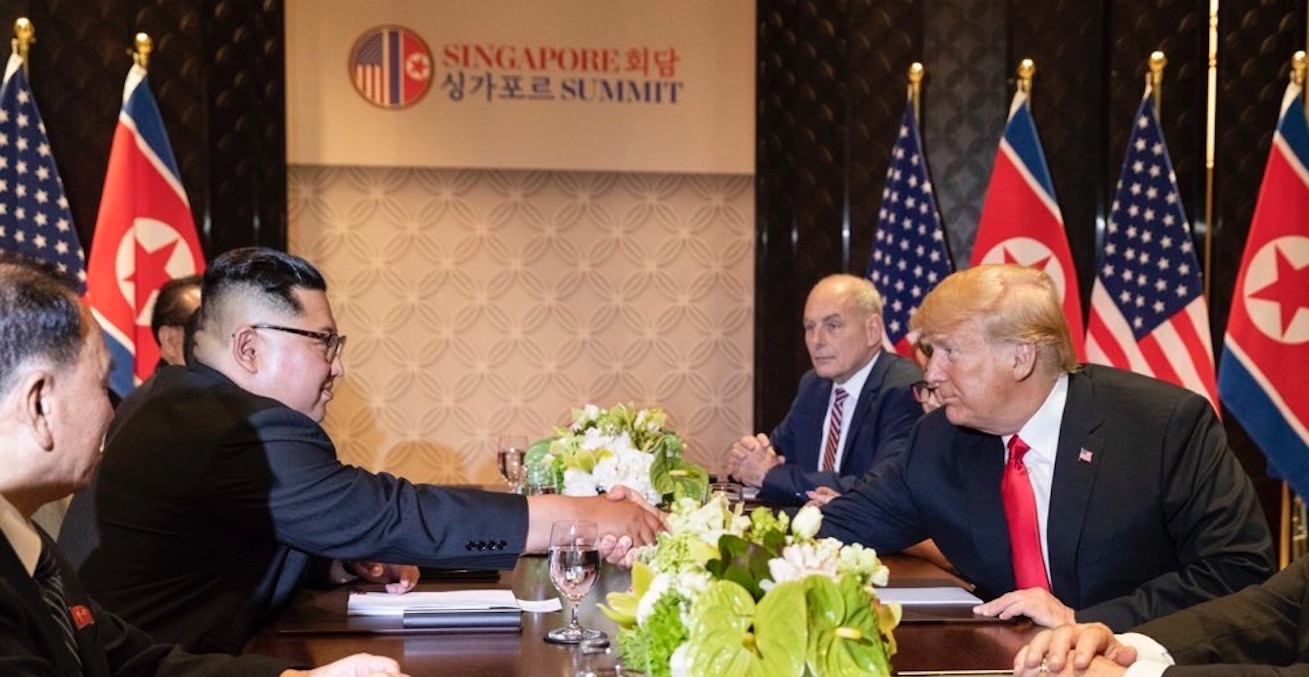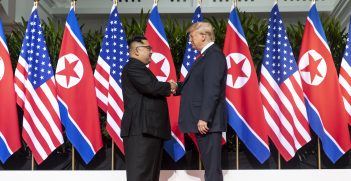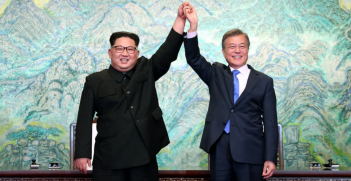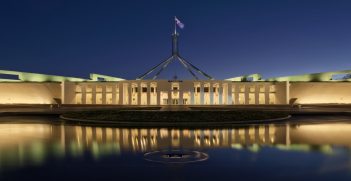The Kim–Trump Summit: Implications For Australia

Following the historic events of last week, the situation on the Korean Peninsula could go one of three ways, each with significant implications for Australia.
Following the historic events of last week, the situation on the Korean Peninsula could go one of three ways.
Back to the brink?
The bare-bones agreement struck by President Trump and Kim Jong-un could unravel very quickly, bringing the US and North Korea back to the brink of war, where they were for much of 2017. This would be a very bad outcome for Australia.
Despite the Singapore Summit seemingly having taken much of the heat out of deepening tensions between Washington and Pyongyang, the prospect of conflict on the Korean Peninsula is one that still cannot be discounted: especially with the erratic Trump and his hawkish National Security Advisor John Bolton in the White House.
Washington would likely expect Australia to become involved in such a conflict. Even in the unlikely event that we chose not to, the economic impact of such a conflict in terms of large-scale capital flight from Northeast Asia and the interruption to trade that would occur could well trigger a recession here. It’s worth keeping in mind that three of Australia’s four leading trading partners – China, Japan and South Korea – share the same geographical neighbourhood as North Korea.
But such a conflict remains unlikely. That is because the Trump Administration, for all its bluster, does not have a credible military option for removing the North’s nuclear weapons.
Late last year, in a letter to the US Congress, the Pentagon advised that a full-scale ground invasion was the only sure-fire way to achieve such an outcome. Tens of millions would likely perish on both sides in such a campaign, especially if the conflict turned nuclear. Amongst those fatalities would likely be hundreds of thousands of Americans residing in South Korea and Japan.
The optimistic outlook
A second possibility, therefore, is that diplomatic negotiations make much better than expected progress, to include perhaps the signing of a peace treaty and the normalisation of US-North Korea diplomatic relations. While it is unlikely that this will lead to a situation where the North denuclearises altogether – along the lines Washington hopes it will – it is still possible to imagine the introduction of a robust arms control regime, as well as the hermit kingdom joining the community of nations politically and economically. As promising as this outcome initially sounds, it is also a potentially dangerous one for Australia.
The biggest risk is that it results in a significant weakening of the US-led network of Asian alliances. Indeed, it is possible that the evaporation of the North Korean threat could well remove the very raison d’etre for the US-South Korea alliance. In his post-summit press conference, Trump stirred controversy when he announced that America was suspending its large-scale military exercises with South Korea on the grounds that these are unduly ‘provocative.’ Moreover, Trump has made no secret of his desire to remove US troops from South Korea.
America has long underestimated the larger strategic value of its alliance with South Korea. During his one-term presidency, Jimmy Carter also tried (unsuccessfully, due largely to Congressional opposition) to bring the troops home from this hotspot.
It is true that the US could retain an Asian presence absent the Korean alliance and the in-theatre troop presence it facilitates. Japan remains, as generations of US policymakers are fond of reminding us, the ‘cornerstone’ of America’s strategic presence in this part of the world.
But the US presence in Asia would be a much weaker one. The door would be left open for China to dominate the strategic crucible that is the Korean Peninsula. Pyongyang’s other traditional patron, Russia, could also be afforded a freer hand. A Northeast Asian balance of power favouring these authoritarian states, including North Korea itself, could ensue.
Stalemate and return to status quo
A third possibility is that the negotiations drag out for some time. Both sides fitfully offer some concessions, sufficient to prevent the drift back to conflict, but not enough to fundamentally transform Northeast Asia’s strategic situation.
Should the Singapore agreement drift towards this kind of stalemate, Washington is likely to revert to doubling down on its strategy of containing the North economically and deterring it militarily. It will struggle to keep China on board, meaning that the campaign of exerting maximum economic pressure against Pyongyang will lose a good deal of its bite. Indeed, as Trump himself conceded in his post-Summit press conference, this is already happening. But Washington will still expect its friends and allies to hold the line economically. Militarily, it will want to leave Pyongyang in no doubt that an intercontinental ballistic missile strike against an American city would mean the end of North Korea as a functioning society.
This is familiar ground for Australia, a long-time US ally and staunch supporter of the United Nations sanctions regime. Some adjustment may be required for Canberra in terms of meeting revised US expectations, especially if Pyongyang succeeds in driving a wedge between America and South Korea. It is not impossible to envisage a situation, for instance, where the Trump-Kim agreement peters out, but where Pyongyang and Seoul continue to make nice following their own historic Panmunjom Summit of April 2018. In such circumstances, Washington may call upon Australia and Japan to work with it more closely to reinforce US conventional deterrence strategies around the Korean Peninsula.
In many respects, history suggests that this return to the status quo is the most likely of the three possibilities.
But precisely because of the truly transformative ramifications of the less likely scenarios – the drift back toward conflict or an improbable diplomatic success – each still require very careful thinking.
If the Singapore agreement unravels and John Bolton gets his way, how should Australia respond to the outbreak of conflict on the Korean Peninsula and, especially, a request from Washington for a military contribution? Some hold the very legitimate view that we simply shouldn’t get involved in such a conflict, but we may not have that luxury if we want to preserve the American alliance, especially given the current occupant of the Oval Office.
But that important debate aside, this would be a war unlike any we have seen. Operations could potentially be conducted in an irradiated environment. Korean conflict could trigger a humanitarian disaster of unimaginable proportions, as millions of North Korean refugees tried to make their way to safety across the 1,400 kilometres long border with China. What could the Australian Defence Force potentially contribute to such a campaign and its aftermath if the government opted to become involved militarily?
Conversely, how and to what extent might Australia be able to contribute to a diplomatic process whose success might potentially not be in our longer-term interest?
Minister for Foreign Affairs Julie Bishop has signaled that the government is already looking into what expertise it can offer to support the verification of North Korean denuclearisation. Australia was also a financial contributor to the Korean Peninsula Energy Development Organisation (or KEDO) which was established to implement the ill-fated 1994 Agreed Framework between the US and North Korea, so there is precedent here also.
But beyond such material contributions, what, if anything, can Canberra do to ensure that Washington and Seoul remain on the same page, to encourage the continuation of their alliance and to prevent the unravelling of the entire US-led Asian alliance network as a byproduct of unexpected diplomatic success? If that network were to unravel, or if the US loses influence on the Peninsula as a result of this process, what hedges are Canberra considering?
These are issues of the utmost strategic importance for Australia. Comforted by the quite well-founded assumption that history is likely to repeat on the Peninsula, we may not be giving them sufficient thought and attention.
Brendan Taylor is Associate Professor of Strategic Studies at the Strategic and Defence Studies Centre, Australian National University. He was the recent recipient of a DFAT Australia-Korea Foundation grant to support a project entitled ‘Korean Peninsula in crisis: building awareness, avoiding conflict’, with Professor Andrew O’Neil of Griffith University and Professor William Tow of ANU.
This article is based on his remarks at a panel discussion with Professor James Cotton at the AIIA ACT Branch on 19 June.
This article is published under a Creative Commons Licence and may be republished with attribution.





